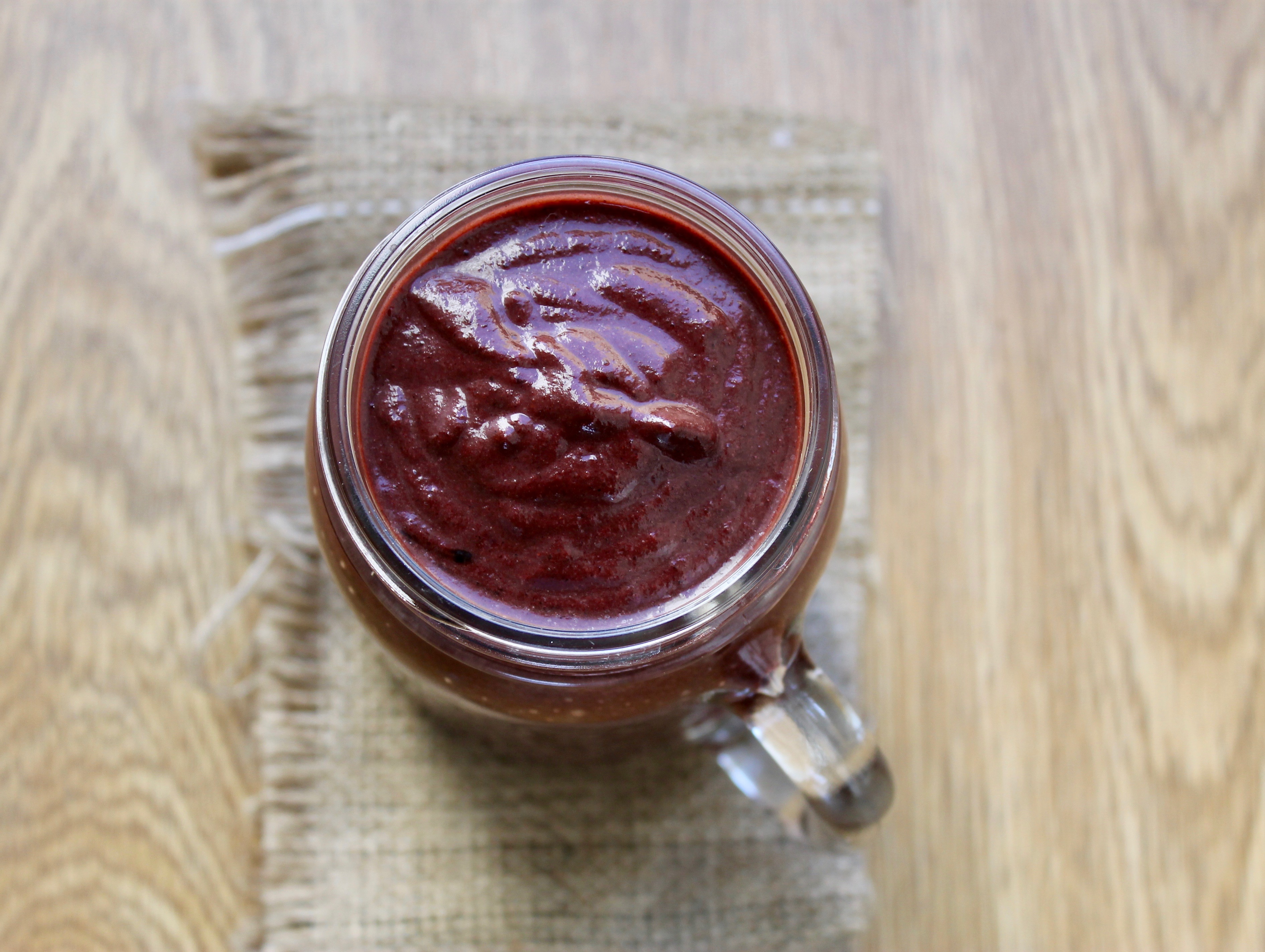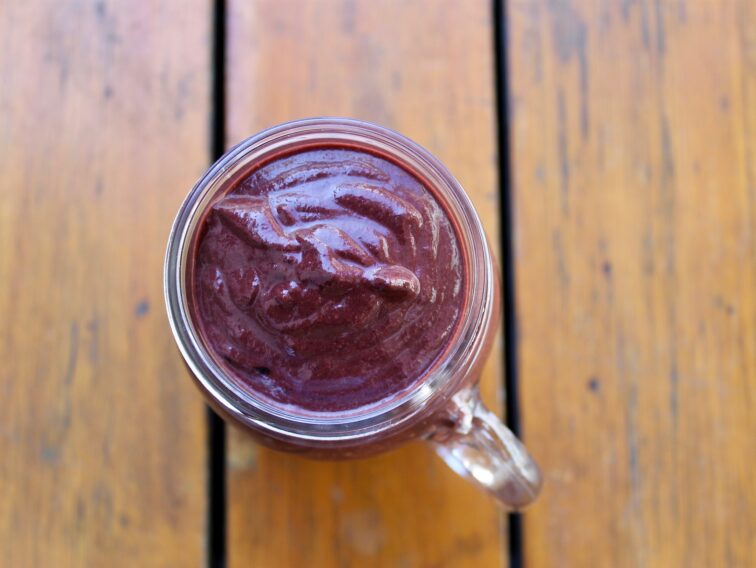The link between Akkermansia and Leaky Gut
Akkermansia is a keystone bacterial strain that supports the balance of the microbiome and helps prevent digestive and metabolic issues.
It feeds off of the healthy mucus that lines our gut. This mucus is very protective and plays an important role in fighting pathogens.
It also eats red polyphenols, which I cover in depth below including an Akkermansia-building smoothie recipe.
Akkermansia’s key role in the biome is to manufacture key nutrients to feed and nurture other bacterial strains.
When Akkermansia is low, it starves other bacterial strains of the nutrients they need to thrive. Low Akkermansia, has a downstream effect on lowering beneficial strains in the biome.
Some of these bacteria strains produce short chain fatty acids called butyrate, which lower inflammation in the large intestine.
Low levels of Akkermansia have been associated with obesity, diabetes, IBS and bowel inflammatory disease.
When in abundance, it supports and increases immune function, lowers inflammation and improves glucose management to help stabilize blood sugar.
Because it feeds on mucus from the gut lining, we can know that when Akkermansia is low that leaky gut is likely present.
A leaky gut can cause food sensitivities, allergies to the environment (pollen, cats, etc.) and autoimmune diseases.
While healing and sealing a leaky gut is important, it is just as important to rebuild Akkermansia, for gut and metabolic health.
Measuring Akkermansia levels
How do you know if Akkermansia is low?
You can test Akkermansia levels easily with a GI Map stool test.
When I took the test a year ago, the results showed low Akkermansia and a leaky gut after being exposed to mold. Earlier, I learned that I also had antibodies attacking my thyroid. This was likely why.
It always empowering to know why something is happening. After identifying the problem, you can start the repair process.
Many people address leaky gut only with repair powders and herbs like glutamine, DGL licorice, aloe vera, slippery elm and marshmallow. While soothing and supportive, it’s not effective. It’s like spackling a wall while it’s being damaged. You need to stop the damage first.
Leaky gut can cause symptoms like digestive issues, aches and pains in the body, headaches, weight gain or loss or food reactions, among other symptoms.
How to boost Akkermansia
To solve my Akkermansia deficiency, I researched how to boost it.
It was a two part process. I needed to focus on sealing my gut lining while also supporting the regrowth of this important bacteria.
To address leaky gut you have to identifying what is causing it. It could be a gut infections/overgrowth, NSAIDs, alcohol, sugar, gluten, food intolerances, stress or another source of inflammation.
For me it was mold toxicity. I had to detox the mold first. And then I turned my attention to repairing the gut and rebuilding my biome.
How to repair leaky gut
Find the root cause (what’s driving inflammation?) The GI Map can help with that.
Clean up and rebalance the biome (this includes boosting Akkermansia if it is low) The gut lining has a synergistic relationship with the biome.
Lower inflammation with diet and supplementation (avoid sugar, coffee, alcohol, gluten) (add in turmeric, fish oil and boswelia)
Use repair herbs to heal the damage (glutamine, marshmallow, aloe, slippery elm, etc.)
How to build up Akkermansia
Feed it with red foods: In studies akkermansia responded to red polyphenols such as red skinned grapes, cranberries, pomegranate, red dragon fruit and red skinned apples.
Red polyphenols are the most targeted intervention, but other polyphenols help support Akkermansia to a lesser degree and the biome generally. Things such as green tea, berries and walnuts. Clove is a spice rich in polyphenols. Below is a recipe for an Akkermansia-building smoothie to help incorporate these foods.
Avoid excess saturated fat in your diet. Animal fat or coconut fat are saturated fats. It is ok to eat them but not in excess. A carnivore diet would not be beneficial for Akkermansia.
Berberine is an herb with antimicrobial properties that has also been shown to support the growth of Akkermansia. It also eradicates yeast, h. pylori and bacterial overgrowth. And helps balance blood sugar.
Other general advice for supporting the biome also applies. Add in prebiotic fiber like flax seeds, or if you react to prebiotics and fiber (due to SIBO) Sun Fiber (partially hydrolyzed guar gum) is safe.
Probiotics can be helpful. Megasporbiotic is a soil-based probiotic that helps repair the gut lining and is SIBO safe. There’s also a new Akkermansia probiotic (only one of its kind) made by Pendulum.
Building your biome is about what you eat
Here’s a delicious way to do it.
You can buy the powdered form of pomegranate, pink dragon fruit and cranberry and easily add them to smoothies, porridge or yogurt.
Bone broth, which contains collagen and amino acids for gut lining repair, can be added to soups or smoothies.
I have several bone broth smoothie recipes (you can’t taste it, I promise) in my Treats That Heal cookbook.
My Akkermansia smoothie recipe
Healing the gut is not just about killing protocols.
Feeding and rebuilding the biome can do just as much good for reducing inflammation, raising immunity, easing symptoms and protecting the body from pathogens.

Ingredients
1/2 cup of coconut yogurt for the probiotics.
1 teaspoon of each powder (dragon fruit, cranberry and pomegranate)
1/2 cup of bone broth OR coconut water OR tigernut milk (recipe in my cookbook) OR use your favorite non diary milk.
1/2 a green (unripe) banana for resistant starch (a prebiotic fiber)
Optional: add a few teaspoons of collagen powder
Optional: add a ripe banana for added sweetness
Optional: matcha green tea or nut butter (walnut butter is a polyphenol)
Blend and enjoy daily (with Akkermansia probiotic from pendulum)


